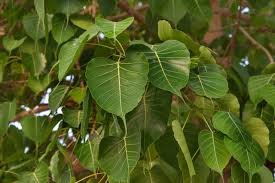
Ficus religiosa or sacred fig is a species of fig native to the Indian subcontinent and Indochina that belongs to Moraceae, the fig or mulberry family. It is also known as the bodhi tree,pippala tree, peepul tree, peepal tree or ashwattha tree (in India and Nepal).The sacred fig is considered to have a religious significance in three major religions that originated on the Indian subcontinent, Hinduism, Buddhism and Jainism. Hindu and Jain ascetics consider the tree to be sacred and often meditate under them. This is the tree under which Gautama Buddha is believed to have attained enlightenment. The sacred fig is the state tree of the Indian states of Odisha and Haryana.
Ficus religiosa is a large dry season-deciduous or semi-evergreen tree up to 30 metres (98 ft) tall and with a trunk diameter of up to 3 metres (9.8 ft). The leaves are cordate in shape with a distinctive extended drip tip; they are 10–17 centimetres (3.9–6.7 in) long and 8–12 centimetres (3.1–4.7 in) broad, with a 6–10 centimetres (2.4–3.9 in) petiole. The fruits are small figs 1–1.5 centimetres (0.39–0.59 in) in diameter, green ripening to purple.
Ficus religiosa is native to most of the Indian subcontinent – Bangladesh, Nepal, Pakistan and India including the Assam region, Eastern Himalaya and the Nicobar Islands, as well as part of Indochina – the Andaman Islands, Myanmar and Peninsular Malaysia. It has been widely introduced elsewhere, particularly in the rest of tropical Asia, but also in Iran, Florida and Venezuela.
Ficus religiosa suitably grows at altitudes ranging from 10 metres (33 ft) up to 1,520 metres (4,990 ft). Due to the climatic conditions which are prevalent throughout different heat zones, it can grow at latitudes ranging from 30°N to 5°S. It can tolerate air temperatures ranging between 0 °C (32 °F) to 35 °C (95 °F), beyond this upper limit its growth diminishes. It grows on a wide variety of soils but preferably needs deep, alluvial sandy loam with good drainage. It is also found on shallow soils including rock crevices
Environmental benefits of Peepal Trees
Ecologically, Peepal Tree provides ample Oxygen, purifies the surrounding, kills harmful bacteria, control soil erosion, improve soil structure and its fertility, it is also dust and sound absorbent. Worshipping trees implies that trees too are a part of the cosmos like us and are serving earth selflessly.
Benefits and Uses of Peepal Tree
For Asthma. The bark of the Peepal plant and its ripe fruits are helpful for treating asthma.
For poor appetite.
For stomach pain.
For eczema and itching.
For a brighter complexion.
For cracked heels.
For toothache.
For eye pain.